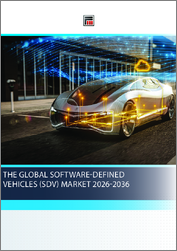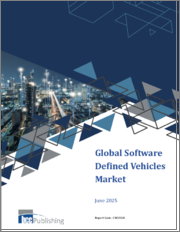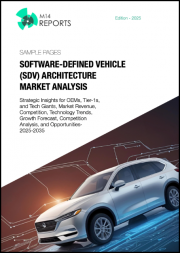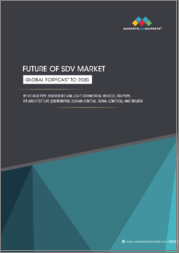
|
시장보고서
상품코드
1642359
소프트웨어 정의 차량 시장 : 제공별, 차종별, 추진 유형별, 차량 자율성별, 전기/전자 아키텍처 유형별, SDV 유형별, 용도별, 지역별, 기회, 예측(2018-2032년)Software-Defined Vehicle Market Assessment, By Offering, By Vehicle Type, By Propulsion Type, By Vehicle Autonomy, By Electrical/Electronic Architecture Type, By SDV Type, By Application By Region, Opportunities and Forecast, 2018-2032F |
||||||
세계 소프트웨어 정의 차량 시장 규모는 2025-2032년 예측 기간 동안 17.10%의 CAGR로 2024년 963억 달러에서 2032년 3,404억 7,000만 달러로 성장할 것으로 예측됩니다. 이 시장은 최근 몇 년 동안 괄목할 만한 성장세를 보였으며, 운전 기술의 급속한 자동화, 차량 안전 기능의 향상, 커넥티드카에 대한 수요 증가, 빠른 커스터마이징으로 인해 향후 몇 년 동안 계속 확대될 것으로 예상됩니다. 자동차 기술의 발전, 구독 모델에 대한 소비자 선호도 증가, 차량 내 하드웨어 기능의 지속적인 개선으로 인해 세계 소프트웨어 정의 차량 시장의 수요가 크게 증가하고 있습니다. 또한, 운전 보조, 충돌 방지 시스템과 같은 안전 기능의 향상, 비디오 스트리밍 및 음악과 같은 커넥티드 기능을 통합한 차량용 인포테인먼트 시스템을 통한 편의성에 대한 수요 증가는 전 세계적으로 소프트웨어 기반 차량에 대한 요구 사항을 촉진할 것으로 예상됩니다. 시장의 기업들은 운전 경험을 개선하고 차량 성능을 향상시키기 위해 다양한 연구 개발 활동에 효율적으로 투자하고 있습니다. 또한, 각국 정부는 도로 안전을 보장하고 교통 사고의 수를 억제하기 위해 다양한 정책을 수립하고 있습니다. 따라서 기업들은 다양한 소프트웨어를 차량에 통합하여 최종사용자가 스마트폰을 차량에 연결하여 새로운 방식으로 차량과 상호 작용할 수 있도록 하고 있습니다.
또한, 차량 내 커넥티비티의 발전과 차량과 실시간 정보 서비스를 제공하는 센서의 통합은 예측 기간 동안 전 세계적으로 소프트웨어 기반 자동차에 대한 수요를 촉진할 것으로 예상됩니다. 세계 소프트웨어 정의 차량 시장의 주요 참여자들은 더 나은 운전 경험과 도로 안전을 제공하기 위해 다양한 소프트웨어 정의 차량용 첨단 시스템과 소프트웨어를 도입하기 위해 협력하고 있습니다.
예를 들어,2024년 7월,Tata Technologies는 Arm Limited와 소프트웨어 정의 차량용 자동차 소프트웨어 및 시스템 솔루션을 개발하기 위해 양해각서를 체결했습니다.
세계의 소프트웨어 정의 차량 시장에 대해 조사했으며, 시장 개요와 함께 제공별, 차량 유형별, 추진 유형별, 차량 자율성 성별, 전기/전자 아키텍처 유형별, SDV 유형별, 용도별, 지역별 동향, 시장 진입 기업 프로파일 등의 정보를 전해드립니다.
목차
제1장 프로젝트 범위와 정의
제2장 조사 방법
제3장 주요 요약
제4장 고객의 소리
제5장 세계의 소프트웨어 정의 차량 시장 전망, 2018-2032년
- 시장 규모 분석과 예측
- 시장 점유율 분석과 예측
- 시장 맵 분석, 2024년
- 제공별
- 차종별
- 추진 유형별
- 차량 자율성별
- 전기/전자(E/E) 아키텍처 유형별
- SDV 유형별
- 용도별
- 지역별
제6장 북미의 소프트웨어 정의 차량 시장 전망, 2018-2032년
제7장 유럽의 소프트웨어 정의 차량 시장 전망, 2018-2032년
제8장 아시아태평양의 소프트웨어 정의 차량 시장 전망, 2018-2032년
제9장 남미의 소프트웨어 정의 차량 시장 전망, 2018-2032년
제10장 중동 및 아프리카의 소프트웨어 정의 차량 시장 전망, 2018-2032년
제11장 수요 공급 분석
제12장 수출입 분석
제13장 밸류체인 분석
제14장 Porter's Five Forces 분석
제15장 PESTLE 분석
제16장 가격 분석
제17장 시장 역학
제18장 시장 동향과 발전
제19장 사례 연구
제20장 경쟁 구도
- 시장 리더 탑 5 경쟁 매트릭스
- 진출 기업 탑 5 SWOT 분석
- 시장의 주요 기업 탑 10 상황
- Aptiv Global Operations Limited
- Samsung Electronics Co., Ltd.
- Continental Automotive Technologies GmbH
- Mobileye Technologies Limited
- NVIDIA Corporation
- Robert Bosch GmbH
- Tesla, Inc.
- Waymo LLC
- Marelli Holdings Co., Ltd.
- Qualcomm Incorporated
- Stellantis N.V.
제21장 전략적 제안
제22장 조사 회사 소개 및 면책사항
ksm 25.02.20Global software-defined vehicle market is projected to witness a CAGR of 17.10% during the forecast period 2025-2032, growing from USD 96.30 billion in 2024 to USD 340.47 billion in 2032. The market has experienced significant growth in recent years and is expected to maintain an expansion in the coming years owing to rapid automation in the driving technology, enhancement in the safety features of vehicles, increased demand for connected vehicles, and rapid customization. The global software-defined vehicle market demand is significantly rising owing to advancements in automotive technology, a rising shift in consumer preferences toward subscription models, and continuous improvements in onboard hardware capabilities. Also, improved safety features, including driver assistance, anti-collision systems, and increased demand for comfort through onboard infotainment systems that integrate connected features, including video streaming and music, are projected to drive the requirement for software-driven vehicles across the globe. Companies in the market are efficiently investing in different research and development activities to improve the driving experience and enhance vehicle performance. In addition, governments of other regions are framing different policies to ensure road safety and control the number of road accidents. Therefore, companies are integrating different software in their vehicles, enabling end-users to connect their smartphone with vehicles to interact with their cars in new ways.
Furthermore, the advancement of in-vehicle connectivity and integration of sensors delivering real-time information services to and from vehicles is also projected to foster the demand for software-driven cars globally in the forecast period. Key participants in the global software-defined vehicles market are collaborating to introduce advanced systems and software for varied software-defined vehicles to offer better driving experience and road safety.
For instance, in July 2024, Tata Technologies signed a Memorandum of Understanding with Arm Limited to develop automotive software and systems solutions for software-defined vehicles.
Increased Adoption of Autonomous Vehicles Drive the Global Software-Defined Vehicle Market Growth
The shift toward autonomous vehicles is witnessing momentum, propelled by artificial intelligence and sensor technology advancements. Companies in the market are significantly investing in research and development to introduce fully self-driving capabilities. The considerable improvements in machine learning, AI, and sensor technologies are making autonomous driving more viable. This boasts a higher requirement for software that can process huge amounts of data in real-time. In addition to the growing concerns over road safety, consumers are more inclined to adopt autonomous vehicles, which often feature advanced safety systems powered by software. Furthermore, governments of emerging countries are increasingly investing in infrastructure and regulations to support the production of autonomous vehicles and compelling companies to integrate different safety features in the vehicles, further accelerating the global software-defined vehicle market growth in the forecast period. Companies are producing autonomous vehicles with advanced software and systems, including navigation, entertainment, and vehicle-to-everything communication, to enhance the driving experience and promote adoption.
For instance, in June 2024, Toyota Kirloskar Motor and its joint venture partner, GAC INTERNATIONAL CO., LTD., a state-owned enterprise in China, announced the launch of an electric vehicle (EV) with autonomous driving capabilities by 2025.
Increasing Integration of AI and Machine Learning in Vehicles Propel Market Demand
The growing integration of AI and machine learning in vehicles significantly fosters demand in the global software-defined vehicle market. These technologies improve the vehicle's capabilities, and advancements in machine learning algorithms are important for the launch of fully autonomous vehicles, accelerating the requirement for sophisticated software solutions in vehicles. However, AI allows vehicles to learn driver preferences, improving convenience and comfort through customized settings for climate control, navigation, and infotainment. In addition, these technologies improve Advanced Driver Assistance Systems (ADAS), allowing features including lane-keeping assistance, adaptive cruise control, and automated emergency braking, significantly enhancing safety, and are expected to accelerate the global software-defined vehicle market demand in the forecast period. Furthermore, over-the-air (OTA) updates confirm vehicles remain updated with software advancements, fostering consumer appeal. Automotive companies significantly leverage data analytics for innovative business models and sustainable practices, fostering the global software-driven vehicle market growth. Also, companies are collaborating and introducing autonomous vehicles equipped with AI and machine learning to enhance safety, user experience, and efficiency.
For instance, in May 2023, Waymo LLC and Uber Technologies Inc. announced a multi-year strategic partnership to bring together Waymo's world-leading autonomous driving technology with the massive scale of Uber's ridesharing and delivery networks.
Passenger Vehicle Dominates the Global Software-Defined Vehicle Market Share
The passenger vehicle segment is leading the global market for software-defined vehicles owing to the rising production of semi-autonomous and autonomous vehicles, increasing demand for advanced features, and enhanced user experiences. Consumers in emerging countries prefer vehicles that offer seamless connectivity, personalization, and safety, forcing automakers to incorporate advanced software solutions that further drive the global software-defined passenger vehicle market growth. The technologies, including machine learning and artificial intelligence, enable infotainment upgrades, advanced driver assistance systems, and over-the-air updates. These appeal to buyers and accelerate the global software-defined passenger vehicle market demand in the forecast period. Companies in the market are introducing software for passenger vehicles to address the growing demand and offer safety coupled with enhancing the overall driving experience.
For instance, in June 2024, LG Electronics Inc. announced the launch of a new suite of software products dubbed 'LG AlphaWare' that can support automakers in introducing immersive in-vehicle experiences for software-defined vehicles.
Asia-Pacific Holds the Largest Market Size in the Global Software-Defined Vehicles Market
Asia-Pacific is presently the largest software vehicle market due to rapid urbanization, a growing presence of advanced automotive technologies, and increasing disposable incomes. Major automakers in countries including China, South Korea, and Japan are significantly investing in research and development of connected and autonomous vehicles, machine learning, and leveraging artificial intelligence to improve functionality and user experience. In addition, the governments of emerging countries are promoting smart mobility and sustainability by forming different initiatives that further drive market growth and offering different market growth opportunities to the companies. Companies are also planning to launch new and advanced models in the market to offer a more comfortable driving experience and promote the adoption of autonomous driving.
For instance, in March 2024, XPENG INC. announced the launch of the X9 ultra-smart large seven-seater in China to provide greater flexibility than an SUV and secure a dominant market share. With the launch of the X9, XPENG enriches its Smart EV portfolio, fascinating primary market requirements and encouraging the adoption of autonomous driving.
Future Market Scenario (2025-2032F)
The rising demand for advanced driver-assistance systems (ADAS) and autonomous driving features makes software-defined vehicles appealing. Their ability to receive updates enhances these capabilities, attracting tech-savvy consumers who prioritize innovation.
Safety features powered by software, such as automated emergency braking and lane-keeping assistance, are becoming essential. This heightened safety focus drives consumer interest in vehicles equipped with advanced software systems.
Rapid advancements in software technology allow continuous feature enhancements in vehicles. Consumers are drawn to the latest innovations, making software-defined vehicles more attractive in a competitive automotive market.
Increased competition from tech companies entering the automotive sector is driving the push for software-defined vehicles. This trend reflects a broader industry shift toward integrating cutting-edge technology into all aspects of vehicle design and functionality.
Key Players Landscape and Outlook
Companies in the global software-defined vehicle (SDV) market are expanding their market presence and product portfolio by leveraging advanced technologies and strategic partnerships. They focus on integrating cutting-edge software solutions, such as over-the-air updates and autonomous driving capabilities, to enhance vehicle functionality and user experience. By adopting a software-centric approach, these companies can rapidly innovate and introduce new features, ensuring continuous improvement and adaptability. Additionally, collaborations with tech firms and investments in research and development enable them to stay ahead of market trends and meet evolving customer demands. This strategy boosts their competitiveness and fosters customer loyalty and satisfaction.
In October 2024, Hyundai Motor Company, Kia Corporation, and Samsung Electronics Co., Ltd. announced a partnership to connect SDV to smartphones and introduce a new mobility experience for customers.
Table of Contents
1. Project Scope and Definitions
2. Research Methodology
3. Executive Summary
4. Voice of Customer
- 4.1. Product and Market Intelligence
- 4.2. Brand Awareness
- 4.3. Factors Considered in Purchase Decisions
- 4.3.1. Features and Other Value-Added Service
- 4.3.2. Compatibility and Software Durability
- 4.3.3. Efficiency of Solutions
- 4.3.4. Software Types
- 4.3.5. After-Sales Services
- 4.4. Consideration of Privacy and Regulations
5. Global Software-Defined Vehicle Market Outlook, 2018-2032F
- 5.1. Market Size Analysis & Forecast
- 5.1.1. By Value
- 5.2. Market Share Analysis & Forecast
- 5.2.1. By Offering
- 5.2.1.1. Hardware
- 5.2.1.2. Software
- 5.2.1.3. Services
- 5.2.2. By Vehicle Type
- 5.2.2.1. Passenger
- 5.2.2.2. Commercial
- 5.2.3. By Propulsion Type
- 5.2.3.1. Internal Combustion Engine Vehicle
- 5.2.3.2. Electric Vehicle
- 5.2.4. By Vehicle Autonomy
- 5.2.4.1. Level 1
- 5.2.4.2. Level 2
- 5.2.4.3. Level 3
- 5.2.4.4. Level 4
- 5.2.4.5. Level 5
- 5.2.5. By Electrical/Electronic (E/E) Architecture Type
- 5.2.5.1. Distributed
- 5.2.5.2. Domain
- 5.2.5.3. Zonal
- 5.2.6. By SDV Type
- 5.2.6.1. Semi-Software Defined Vehicle
- 5.2.6.2. Software Defined Vehicle
- 5.2.7. By Application
- 5.2.7.1. Advanced Driver Assistance System
- 5.2.7.2. Infotainment and Connectivity
- 5.2.7.3. Powertrain and Energy Management
- 5.2.7.4. Body Control and Comfort Systems
- 5.2.7.5. Autonomous Driving
- 5.2.7.6. Others
- 5.2.8. By Region
- 5.2.8.1. North America
- 5.2.8.2. Europe
- 5.2.8.3. Asia-Pacific
- 5.2.8.4. South America
- 5.2.8.5. Middle East and Africa
- 5.2.9. By Company Market Share Analysis (Top 5 Companies and Others - By Value, 2024)
- 5.2.1. By Offering
- 5.3. Market Map Analysis, 2024
- 5.3.1. By Offering
- 5.3.2. By Vehicle Type
- 5.3.3. By Propulsion Type
- 5.3.4. By Vehicle Autonomy
- 5.3.5. By Electrical/Electronic (E/E) Architecture Type
- 5.3.6. By SDV Type
- 5.3.7. By Application
- 5.3.8. By Region
6. North America Software-Defined Vehicle Market Outlook, 2018-2032F*
- 6.1. Market Size Analysis & Forecast
- 6.1.1. By Value
- 6.2. Market Share Analysis & Forecast
- 6.2.1. By Offering
- 6.2.1.1. Hardware
- 6.2.1.2. Software
- 6.2.1.3. Services
- 6.2.2. By Vehicle Type
- 6.2.2.1. Passenger
- 6.2.2.2. Commercial
- 6.2.3. By Propulsion
- 6.2.3.1. Internal Combustion Engine Vehicle
- 6.2.3.2. Electric Vehicle
- 6.2.4. By Vehicle Autonomy
- 6.2.4.1. Level 1
- 6.2.4.2. Level 2
- 6.2.4.3. Level 3
- 6.2.4.4. Level 4
- 6.2.4.5. Level 5
- 6.2.5. By Electrical/Electronic (E/E) Architecture Type
- 6.2.5.1. Distributed
- 6.2.5.2. Domain
- 6.2.5.3. Zonal
- 6.2.6. By SDV Type
- 6.2.6.1. Semi-Software Defined Vehicle
- 6.2.6.2. Software Defined Vehicle
- 6.2.7. By Application
- 6.2.7.1. Advanced Driver Assistance System
- 6.2.7.2. Infotainment and Connectivity
- 6.2.7.3. Powertrain and Energy Management
- 6.2.7.4. Body Control and Comfort Systems
- 6.2.7.5. Autonomous Driving
- 6.2.7.6. Others
- 6.2.8. By Country Share
- 6.2.8.1. United States
- 6.2.8.2. Canada
- 6.2.8.3. Mexico
- 6.2.1. By Offering
- 6.3. Country Market Assessment
- 6.3.1. United States Software-Defined Vehicle Market Outlook, 2018-2032F*
- 6.3.1.1. Market Size Analysis & Forecast
- 6.3.1.1.1. By Value
- 6.3.1.2. Market Share Analysis & Forecast
- 6.3.1.2.1. By Offering
- 6.3.1.2.1.1. Hardware
- 6.3.1.2.1.2. Software
- 6.3.1.2.1.3. Services
- 6.3.1.2.2. By Vehicle Type
- 6.3.1.2.2.1. Passenger
- 6.3.1.2.2.2. Commercial
- 6.3.1.2.3. By Propulsion
- 6.3.1.2.3.1. Internal Combustion Engine Vehicle
- 6.3.1.2.3.2. Electric Vehicle
- 6.3.1.2.4. By Vehicle Autonomy
- 6.3.1.2.4.1. Level 1
- 6.3.1.2.4.2. Level 2
- 6.3.1.2.4.3. Level 3
- 6.3.1.2.4.4. Level 4
- 6.3.1.2.4.5. Level 5
- 6.3.1.2.5. By Electrical/Electronic (E/E) Architecture Type
- 6.3.1.2.5.1. Distributed
- 6.3.1.2.5.2. Domain
- 6.3.1.2.5.3. Zonal
- 6.3.1.2.6. By SDV Type
- 6.3.1.2.6.1. Semi-Software Defined Vehicle
- 6.3.1.2.6.2. Software Defined Vehicle
- 6.3.1.2.7. By Application
- 6.3.1.2.7.1. Advanced Driver Assistance System
- 6.3.1.2.7.2. Infotainment and Connectivity
- 6.3.1.2.7.3. Powertrain and Energy Management
- 6.3.1.2.7.4. Body Control and Comfort Systems
- 6.3.1.2.7.5. Autonomous Driving
- 6.3.1.2.7.6. Others
- 6.3.1.2.1. By Offering
- 6.3.1.1. Market Size Analysis & Forecast
- 6.3.2. Canada
- 6.3.3. Mexico
- 6.3.1. United States Software-Defined Vehicle Market Outlook, 2018-2032F*
All segments will be provided for all regions and countries covered
7. Europe Software-Defined Vehicle Market Outlook, 2018-2032F
- 7.1. Germany
- 7.2. France
- 7.3. Italy
- 7.4. United Kingdom
- 7.5. Russia
- 7.6. Netherlands
- 7.7. Spain
- 7.8. Turkey
- 7.9. Poland
8. Asia-Pacific Software-Defined Vehicle Market Outlook, 2018-2032F
- 8.1. India
- 8.2. China
- 8.3. Japan
- 8.4. Australia
- 8.5. Vietnam
- 8.6. South Korea
- 8.7. Indonesia
- 8.8. Philippines
9. South America Software-Defined Vehicle Market Outlook, 2018-2032F
- 9.1.1. Brazil
- 9.1.2. Argentina
10. Middle East and Africa Software-Defined Vehicle Market Outlook, 2018-2032F
- 10.1.1. Saudi Arabia
- 10.1.2. UAE
- 10.1.3. South Africa
11. Demand Supply Analysis
12. Import and Export Analysis
13. Value Chain Analysis
14. Porter's Five Forces Analysis
15. PESTLE Analysis
16. Pricing Analysis
17. Market Dynamics
- 17.1. Market Drivers
- 17.2. Market Challenges
18. Market Trends and Developments
19. Case Studies
20. Competitive Landscape
- 20.1. Competition Matrix of Top 5 Market Leaders
- 20.2. SWOT Analysis for Top 5 Players
- 20.3. Key Players Landscape for Top 10 Market Players
- 20.3.1. Aptiv Global Operations Limited
- 20.3.1.1. Company Details
- 20.3.1.2. Key Management Personnel
- 20.3.1.3. Products and Services
- 20.3.1.4. Financials (As Reported)
- 20.3.1.5. Key Market Focus and Geographical Presence
- 20.3.1.6. Recent Developments/Collaborations/Partnerships/Mergers and Acquisition
- 20.3.2. Samsung Electronics Co., Ltd.
- 20.3.3. Continental Automotive Technologies GmbH
- 20.3.4. Mobileye Technologies Limited
- 20.3.5. NVIDIA Corporation
- 20.3.6. Robert Bosch GmbH
- 20.3.7. Tesla, Inc.
- 20.3.8. Waymo LLC
- 20.3.9. Marelli Holdings Co., Ltd.
- 20.3.10. Qualcomm Incorporated
- 20.3.11. Stellantis N.V.
- 20.3.1. Aptiv Global Operations Limited
Companies mentioned above DO NOT hold any order as per market share and can be changed as per information available during research work.



















